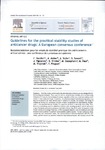Guidelines for the pratical stability studies of anticancer drugs: A European consensus conference
| dc.contributor.author | Sewell, GJ | |
| dc.contributor.author | Bardin, C | |
| dc.contributor.author | Astier, A | |
| dc.contributor.author | Vulto, A | |
| dc.contributor.author | Vigneron, J | |
| dc.contributor.author | Trittler, R | |
| dc.contributor.author | Daouphars, M | |
| dc.contributor.author | Paul, M | |
| dc.contributor.author | Trojniak, M | |
| dc.contributor.author | Pinguet, F | |
| dc.date.accessioned | 2015-10-27T16:08:34Z | |
| dc.date.available | 2015-10-27T16:08:34Z | |
| dc.date.issued | 2011 | |
| dc.identifier.issn | 2047-9956 | |
| dc.identifier.issn | 2047-9964 | |
| dc.identifier.uri | http://hdl.handle.net/10026.1/3701 | |
| dc.description.abstract |
StabilityStability studies performed by the pharmaceutical industry are only designed to fulfil licensing requirements. Thus post-dilution or reconstitution stability data are frequently limited to 24 h only for bacteriological reasons, regardless of the true chemical stability, which could, in many cases, be longer. In practice, the pharmacy based centralised preparation may require infusions to be made several days in advance to provide, for example, the filling of ambulatory devices for continuous infusions or batch preparations for dose banding. Furthermore, a non-justified limited stability for expensive products is obviously very costly. Thus there is a compelling need for additional stability data covering practical uses of anticancer drugs. A European consensus conference was held in France in May 2010, under the auspices of the French Society of Oncology Pharmacy (SFPO), to propose adapted rules on stability in practical situations and guidelines for performing corresponding stability studies. For each anticancer drug, considering their therapeutic index, pharmacokinetics/pharmacodynamics (PK/ PD) variability, specific clinical use and risks related to degradation products (DPs), the classic limit of 10% of degradation can be inappropriate. Therefore, acceptance limits must be clinically relevant and should be defined for each drug individually. Design of stability studies has to reflect the different needs of clinical practice (preparation for the weekends, outpatient transportations, implantable devices, dose banding). It is essential to use validated stability indicating methods, separating degradation products being formed in the practical use of the drug. Sequential temperature designs should be encouraged to replicate problems seen in daily practice such as rupture of the cold-chain or temperature-cycling between refrigerated storage and ambient in-use conditions. Stressed conditions are recommended to evaluate not only the role of classic variability factors (ie, pH, temperature, light) but also mechanical stress. Physical stability, such as particle formation, should be systematically evaluated. The consensus conference focused on the need to perform more studies on the stability of biotherapies, including a minimum of three complementary separating methods and careful evaluation of submicronic aggregates. The determination of biological activity of proteins could be also useful. A guideline on the practical stability of anticancer drugs is proposed to cover current clinical and pharmaceutical practices. It should contribute to improved security of use, optimization centralised handling and reduced costs. Finally, we have attempted to establish a new drug. | |
| dc.format.extent | 278-285 | |
| dc.language | en | |
| dc.language.iso | en | |
| dc.publisher | BMJ | |
| dc.title | Guidelines for the pratical stability studies of anticancer drugs: A European consensus conference | |
| dc.type | journal-article | |
| dc.type | Article | |
| plymouth.author-url | https://www.webofscience.com/api/gateway?GWVersion=2&SrcApp=PARTNER_APP&SrcAuth=LinksAMR&KeyUT=WOS:000309584800004&DestLinkType=FullRecord&DestApp=ALL_WOS&UsrCustomerID=11bb513d99f797142bcfeffcc58ea008 | |
| plymouth.issue | 3 | |
| plymouth.volume | 19 | |
| plymouth.publication-status | In preparation | |
| plymouth.journal | Annales Pharmaceutiques Françaises | |
| dc.identifier.doi | 10.1136/ejhpharm-2012-000112 | |
| plymouth.organisational-group | /Plymouth | |
| plymouth.organisational-group | /Plymouth/Faculty of Health | |
| plymouth.organisational-group | /Plymouth/REF 2021 Researchers by UoA | |
| plymouth.organisational-group | /Plymouth/REF 2021 Researchers by UoA/UoA03 Allied Health Professions, Dentistry, Nursing and Pharmacy | |
| plymouth.organisational-group | /Plymouth/REF 2021 Researchers by UoA/UoA03 Allied Health Professions, Dentistry, Nursing and Pharmacy/UoA03 Allied Health Professions, Dentistry, Nursing and Pharmacy MANUAL | |
| plymouth.organisational-group | /Plymouth/Research Groups | |
| plymouth.organisational-group | /Plymouth/Research Groups/Institute of Health and Community | |
| plymouth.organisational-group | /Plymouth/Users by role | |
| dc.identifier.eissn | 2047-9964 | |
| dc.rights.embargoperiod | Not known | |
| rioxxterms.versionofrecord | 10.1136/ejhpharm-2012-000112 | |
| rioxxterms.licenseref.uri | http://www.rioxx.net/licenses/all-rights-reserved | |
| rioxxterms.type | Journal Article/Review |


